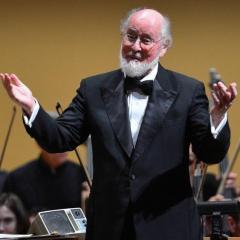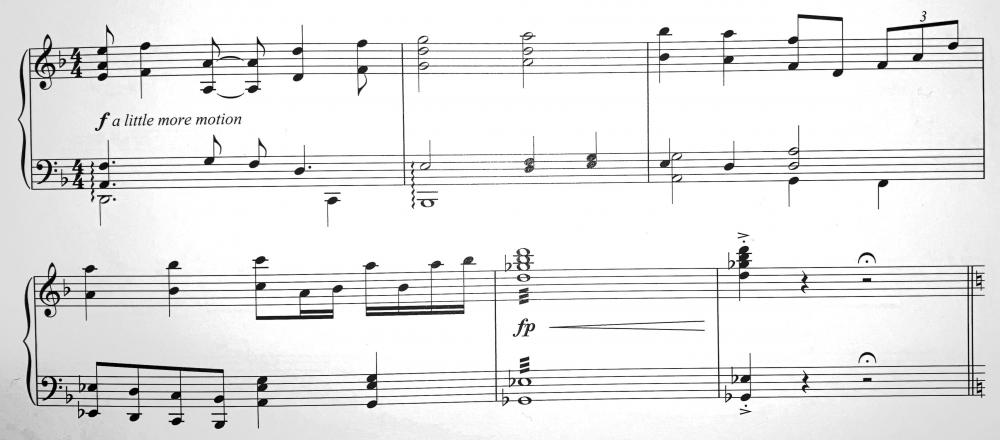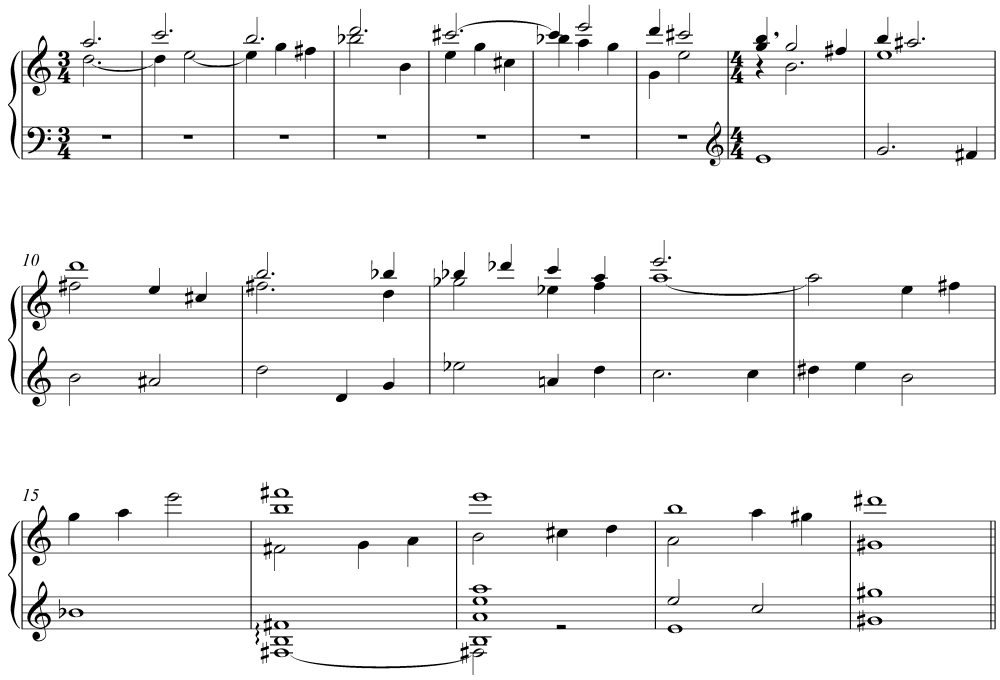Search the Community
Showing results for tags 'Episode IX'.
-
We get some really nifty statements of The Emperor's Theme in Episode 9. What's your favorite, and why? These are the instances I could discern, but may be missing one or two. It's not always clear to me what was intended where, and there are a few statements that are clearly tracked in multiple places. (And who knows what else lurks in the unheard pages of Williams's phantom TROS score). Notes on the poll: * - This is a very slightly rearranged, chorus-free restatement of the theme from ROTJ, R10P2 (The Emperor Confronts Luke) ** - This appears to be a tracked restatement of the beginning of ROTS 7m3 (Birth of the Twins) For reference, here's a compilation someone made
-
To me, one of The Rise of Skywalker's most endearing qualities is the number of short, transient melodies and motifs that are heard just once or twice. These tend to be unrelated to the series's main catalogue of leitmotifs, and they aren't really set-piece themes either since they don't draw attention to themselves like "The Asteroid Field" or "Flag Parade" do. Nevertheless, I find these little one-offs quite essential to the overall warm, humane tone of this score as a whole. Here's a sample of what I'm talking about: Leia Trains Rey. Two distinct statements, at 0:10:33 and 0:13:24, neither on OST. Luke Trains Leia. Two distinct statements, one on OST (Track 6, 1:28) but cut from film, one in film (1:33:18) but cut from OST. Children's School. One statement, at 0:22:56, not on OST. Zorii's Farewell. One statement, on OST (Track 8, 0:24) and in film at 0:55:01. What do you all think? What other short, non-leitmotivic moments from Episode 9 caught your attention?
-
Here's a theme that doesn't get much love -- The Knights of Ren motif: It's not quite the most original of Williams's themes. Heck, it's about as generic as you can get in his style: a repeated note, followed by semitonal double neighbor figure. Blame it on the uninspired, underwritten antagonists it's supposed to depict, I guess. Perhaps the theme's punch is diminished due to a certain fuzziness of signification. In fact, on my first couple of listens I took it, wrongly, to be an additional Kylo Ren theme. The main culprit in this confusion is the first, ear-grabbing rendition accompanies the big Exegol building during the opening sequence -- not the KoR themselves. (Whether this is tracked, spliced, or something else I have no clue.) Still, there are some neat treatments throughout the score. My favorite is probably for the reforging scene (2M2), owing to the slippery string accompaniment and the way it kind of lines up with the rhythm of the hammer strikes. It's also noteworthy that, right away, we're getting two different versions of the theme, one that begins on the 5th scale degree (as on Exegol) and one that begins on the tonic (reforging). What I'm really interested to hear JWfan's opinion on in is the ostinato figure underneath the theme in 3M6 "Knights of Ren," which accompanies their "cool" aerial pose after landing on Pasaana. (Starts at 47 seconds below) Tell me that doesn't sound a little -- even a lot -- like the ostinato from Duel of the Fates? Has this been remarked upon elsewhere? The DOTF-line is extremely hard to hear clearly against soundeffects, but I'm fairly certain it's either G-A-G-F#-E, A-A-G-F#-E, or a combination of the two. Maybe relevant that E-minor is the key DoTF is most strongly associated with, and that's what this cue is in too. And rumor had it that Williams did record some form of DoTF for Episode 9. Anyone able to clean up the audio here to make that ostinato more audible? Edit: Listening even more carefully, I'm not hearing DotF that much any more in this cue -- instead, I'm getting a Bb-A-Bb-A-G-E-E pattern. But it's still very hard to make out discrete pitches. Oh well!
-
I've been putting off starting another of these TROS track appreciation threads, because honestly talking Star Wars feels so exhausting lately. But I happened to listen the cue "Farewell" this morning and was again reminded how superb this piece is, probably the emotional heart of the soundtrack as a whole and a grand musical payoff for so many things Williams was doing in the Sequel Scores. In a way, the power of this cue has a lot to do with the fact that Williams was forced to communicate through music what the screenplay was unable (IMHO) to accomplish: make for a convincing romantic catharsis for the underwritten Rey & Ben relationship, and convey suitable sense of galaxy-wide triumph against the ill-defined First Order. In that respect, I find it similar to some of the best stuff he did for the PT, like "The Dinner Scene," "It Can't Be," and "Lament," where the music massively picks up the slack where the writing & acting falls short. It's a really dense track, with too much to delve into in one post, but here are a few observations: The austere rendition of Rey's theme for her momentary death is exquisite, and by using the comparatively rare ending first (and only?) heard in TFA's 1M7, does a great job tying the beginning and ending of the trilogy together w/r/t her leitmotif. The music that accompanies Kylo Ren dragging himself out of the pit, with those overlapping statements of his motif over a D pedal, is almost Gabriel Yared-like in its dissonant but tonal longing. Delicious stuff. Rey's resurrection is accompanied by what I imagine many Reylos were long hoping for -- a sort of synthesis of her and Kylo Ren's themes. Notice the way melodic semitones, the markers of Ren/Ben's leitmotif, seem to push through all over the place. There's a particularly subtle way in which Ren's former 5-#4 gets turned into b6-5 and then later inverted to 5-b6 which probably deserves more study. The way this surge of musical emotion end prematurely on an unresolved chord calls to mind the other most notable time Williams did this in Star Wars, and prepares nicely the kiss music that follows on its heels. Here's the notation from the (terrific) piano album: Everything following Ben's death, from the tiny bit of string-section mourning Rey is allowed for Ben to the Bb-major choral hymn that concludes the track is such vintage Williams musical exultation that I dare say the whole ST was worth it if just for this sonic reward. And while simple in its emotional effect, the music is again anything if simplistic -- there's even more cool motivic transformations happening with that 5-b6 motif, which flowers into part of the Victory Theme proper. Plus what I suspect is a reconfiguration of the March of the Resistance at 4:14 that I haven't seen anyone else remark on (or maybe I'm just hearing things, wouldn't be the first time!). I'd love to hear all your thoughts, and see what else is going on in this track that I'm surely missing.
-
Another week, another underappreciated aspect of the Rise of Skywalker score to explore. This time, let's talk about the big new villain theme, "Psalm of the Sith." (Better known as "Anthem of Evil" but I just cannot stomach that name!) My first two impressions of the theme were I love the wordless acapella statement on track 7 of the OST; closest we get in this score to the "Legend of Darth Plageuis" unreleased snippet from ROTS we all love... This is kind of just an ersatz Imperial March, more technically fluent but maybe not much more original than Giacchino's Imperial Suite themes... Since getting to know the score much better over the past few months, I've grown to appreciate the leitmotif quite a bit more, especially after revelations like what @Ludwig pointed out last week concerning its development in "Advice." It's treated quite flexibly over the course of the TROS soundtrack, seeping into many moments where the theme isn't necessarily at the forefront. There are also some new touches, harmonically, like the emphasis on the minor-triad immediately below the tonic (e.g. Cm <=> Bm) which is fairly rare in Star Wars and a nice alternative to the over-familiar Cm<=>Abm evil progression. My favorite part has got to be the explosive and well-rounded statement of the theme in its full glory during the End Credits. I especially enjoy the build-up starting at 2:06 (shades of the Force Theme's dotted rhythm) and, even more, the delightfully gothic middle section. This 10 measure span has got to be one of the best but least-remarked-upon aspect of this entire score. Here's a transcription. Could have come straight out of Dracula or The Chamber of Secrets. If anyone can discern even a passing hint of this B-section in the score proper, say so, I am just itching to add it to my thematic catalogue.
-
Another week, another great cue from The Rise of Skywalker to talk about. Since a lot of what we've been celebrating in this score has been its leitmotivic richness, I thought I'd change things up and offer a piece that is pretty athematic on the surface: the FYC track "Advice" (or, probably more properly, 7m8 "Father Knows Best"). I don't have a whole lot to say about this sequence, other than it strikes me as very effective, more so because Williams avoids any too on-the-nose statement of Kylo Ren's themes here. There's a few other cues in SW that feature this sort of two-voice counterpoint in high strings ("Death of Dooku" comes to mind), but this is the most poignant. The closest comparison I can draw is with the similarly evocative, sad "Watching the Eclipse" from Angela's Ashes. There's no direct reference to "Torn Apart," to my ears, but the harmonic language in m. 16 does venture into similar harmonic territory). Instead of further analysis, I thought I'd offer a transcription of the stringy part, before the orchestra swells and Kylo/Ben tosses his saber. (Alas, this one's by ear and thus prone to inaccuracy, esp. in rhythm -- no score leaks for this one unfortunately AFAIK...)
-
I've been meaning to get another thread going for analyzing and appreciating a track from The Rise of Skywalker. So what does everyone think of "Approaching the Throne" (7m20), a true knock-out cue in my opinion. I can get the ball rolling by offering a section-by-section breakdown. It's a stupendously rich piece of music in terms of thematic references and developments -- at least 10 independent motivic components, and I'm probably missing a few important details. Apologies too if this is restating stuff that's already been identified and discussed. 0:00-0:20: Deep, slow procession in D-minor, with a Halting Rhythmic Figure, scurrying strings and growing dissonance. Weirdly, the FYC and film version begins in C-minor, and modulates halfway through to D. Unclear if this is the sign of an alternate version of the cue or another instance of inexplicable pitch-shifting -- maybe because "The Battle of the Resistance" it succeeds ended in C. Also, that Halting Rhythmic Figure appears in an unreleased bit of score of the overall sequence (1:40:46) when Rey first takes the Exegol elevator down: there it's in F-minor -- again, not clear if it's pitch-shifted or a genuinely new variant? 0:20-0:45: A big swell onto a D-minor chord for the Palpatine Throne, gathering dissonance after its initial "reveal." 0:45-0:58: More highly dissonant, atonal material; dialed-out in the film in favor of Sith chanting. 0:58-1:15: Statement of an Insidious Minor Figure motif in parallel minor thirds (C-B-D-Eb-A) that comes up here and a few other occasions on Exegol. Related to the Psalm of the Sith leitmotif. Followed by a squirmy cousin of of the Sith Wayfinder motif (1:06) and a very brief Psalm of the Sith tag in muted brass (Eb-Gb-F). 1:15-1:30: Harmonically "darkened" version of Rey's Theme under Palpatine's dialogue that gives way to a couple of suspenseful chords. 1:30-2:00: Two rotations through the Psalm of the Sith-derived Canon, first on A-minor, then, because of the imitation at the minor-third, F#-minor. Quite clearly inspired by "Palpatine's Instructions" from ROTS to my ears (and, by extension, Vaughan Williams's 6th symphony). Appropriate, since he's once again literally instructing someone, now Rey on how she needs to kill him. Previewed elsewhere in the score in some interesting ways. 2:00-2:15: Big (and last?) statement of the Sith Wayfinder Motif, overlain with the Insidious Minor Figure. I love this moment. 2:15-2:30: Cut to space-battle, with music that recalls Psalm of the Sith (E-G-F#-A#) in melodic outline but even more-so Tension in rhythm and affect. Cool contrapuntal interplay between higher-strings on this idea and lower instruments continuing with it around 2:23. Naturally, all of this fantastic musical detail is virtually inaudible in the film. 2:32-2:43: Completely new Battle Theme in A-minor, especially notable b/c its close to being "grammatical" in @Ludwig's terms, having a pretty balanced beginning/middle/end structure. If anyone can point to precedents or links between this melody and other parts of the score, I would love to know! (And I bet @BrotherSound too) 2:43-2:46: Little return to the Tension idea from before, transitions to... 2:47-2:54: A key-change to C-min and second, incomplete statement of new Battle Theme from the winds. 2:54-3:11: A great pair of chromatic sequences, first down (Fm - DbM7/F - E - CM7/E - Ebm - CbM7/Eb) then back up from Em to Fm. Some familiar Williamsy wind+xyl stabs in there too. 3:11-3:19: A quite glorious trumpet statement of the TROS Victory Theme in D-major. Replaced in the film by a splice of the 2:32 Battle Theme for...reasons? 3:20-3:25: Two phrases worth of very ANH-flavored pounding dissonant chords, like Bbm/A. 3:25-3:40: Big C-minor statement of the March of the Resistance, one of the best in the series, and possibly its last. A lot of orchestrational details in strings and winds that are hard to pick out on the recording. 3:40-3:54: Some very tense but non-motivic interstitial material, serving to build up to... 3:55-End: "The time has come!" for a huge choral outburst on B-minor chord, intoning some as-yet unidentified text. The closest we get to Duel of the Fates in the Sequel Trilogy.
-
Let's celebrate another cue from TROS -- "The Old Death Star" (or 5m10, "Landing At?")! What strikes me most about this cue is how dense it is leitmotivically. It reminds me of certain cues from ROTJ where Williams really is approaching the level of thematic density of late Wagner. Not every second on this track is based on some preexisting theme, of course, but the way that he transitions into and out of familiar material, and how he allows musical tension to ebb and flow as a result, is pretty masterful. The first 25 seconds give us this neat, twisted play on the Psalm of the Sith theme (with hints, intentional or not, to the middle section of Across the Stars). That builds to the first climax, pathetically dialed down in the film-mix, when the Death Star II wreckage is revealed. A missed opportunity to revive the original DS motif, I suppose, but what we get instead is quite cool all the same, with that hectic string figure in Ab-minor that suggests a sped-up version of the Imperial March. Then at 0:31 it's back to the ominous mood of the beginning, and a new spin on that Psalm's twisted bass-line, even more redolent to my ears of ATS at this point. A second build-up section follows for Rey's use of the ridiculous Maguffin surveying-equipment, and for it we a quickly intensifying series of musical layers leading inexorably to the most famous villain theme of all time. First a Dotted Triplet Figure in the reeds (recalling an accompanimental gesture to ROTJ, R10P2, among other things). Then we get a swelling set of high polychords that are based on the new Sith Artifact leitmotif, terrifically orchestrated, all over a pounding C pedal. And finally, of course, the massive statement of the Imperial March at 1:04 in gloriously evil C-minor. This iteration of the March is clearly the most impressive statement of that theme in the entire Sequel Trilogy, and a contender for best version since AOTC in my mind. I love how it builds to its own internal climax with the rising trumpets around 1:15, and how Williams opts to support the penultimate chord with an F bass note (rather than the more standard Ab). It's a chance for last send-off for this iconic theme, and Williams milks it for all its worth. I could go on about the rest of the cue/track, but maybe this is enough to spur discussion!
-
Hi everyone. In the same spirit as the "A New Home" from TROS appreciation thread, I thought I'd kick off discussion of another stand-out cue from The Rise of Skywalker. I'm tempted to call "Falcon Flight" the best action cue from Episode 9, though far too many of its attractions are obscured in the film mix to notice. It seems to me to be as good a synthesis as we could ask for of the thematic richness of the OT action-style with the PT and ST's emphasis on quick changing gestures and repetitive ostinati. Over its brief duration, we get series-standout renditions of: 0:12 - Emperor's Theme. I simply love this arrangement, especially the atypical tritonal bass motion for the F#m - Am/C progression. 0:30, 0:45, 1:30 - March of the Resistance, really being used in an exciting and integral way 0:57, 2:05 - Rebel Fanfare, giving more proof that JW now treats it as much as an all-purpose hero theme (or Millennium Falcon theme) than something specifically for the Rebellion. 1:14 - New Heroics Motif, which seems to sprout from Poe's Theme and the Main Theme so seamlessly. And what trumpet writing! It's not just themes: I think channeling of the OT's harmonic language is nowhere more exact, down to the pitch-perfect Db(#4)/G => C cadence at the end, bringing us right back the ANH's sound-world (and, by extension, Holst's Mars). The new "one-cue-wonder" material is great too. I love how each of the three lightspeed jump destinations garners its own distinct musical material. And underneath much of it, a vigorous string ostinato that nods back, intentionally or not (I think intentionally -- it's too on-point!) to Hyperspace from ESB. And note how the string figure, while consistent as a texture, is actually never repeated for more than a measure or two without some substantial musical alteration. (cf. "The Master Switch" from Rogue One to see the difference between a master and an imitator..) What do you all think?
-
Now that the dust has settled a bit since December, I thought it might be nice to start a discussion on some of the highlights of The Rise of Skywalker's score. Technically, "A New Home" is Williams's apparent final word for this franchise (since the Force Theme statement that follows is repurposed from TFA...which was repurposed from ROTS...which was repurposed from ANH). And, thank goodness Williams is finally allowed some space to breathe musically, with no dialogue, cuts, or sound effects to distract us. It's a subtle and quite desolate piece of music to my ears, and on first glance perhaps exceedingly simple. But over its brief 1:50 duration, it actually conveys a wealth of complex emotions and musical allusions amidst those pacing minor arpeggios. There's obvious and not-so-obvious nods to Rey's Theme, plus Jedi Steps & maybe the Imperial March, or even Across the Stars, with that time signature and the prominent rising minor sixth interval. I can't help but discern a dash of Shmi's Funeral from AOTC -- a hugely apposite reference, albeit unlikely an intentional one. It's at once a piece that summarizes a lot of the music of Star Wars, while still standing quite apart. Despite my utter distaste for this scene from a narratival and character perspective, its hard for me to deny that it really lands on an emotional level. What do you all think?
-
Like this post if you want JW to do a cameo for SW Ep. IX. EDIT: By popular demand, here's the real petition. Spread the good word! EDIT: We've just passed 1200 signatures!
- 137 replies
-
- Episode IX
- Cameo
-
(and 3 more)
Tagged with:















